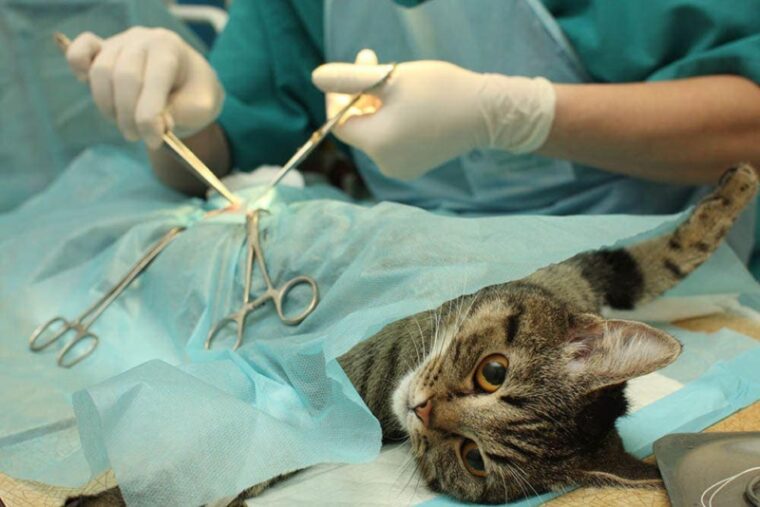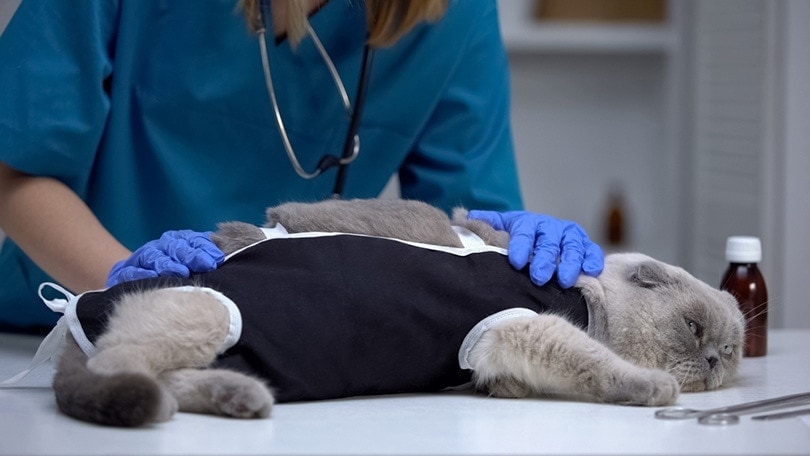
Spaying your cat is one of the most important decisions you can make for her long-term health and wellbeing. The average lifespan of spayed and neutered cats and dogs is significantly longer than their intact counterparts.
There are many benefits to this common and routine surgery, including preventing unwanted litters, helping to reduce feral cat populations, and reducing the risk of reproductive cancers and health problems. If you’re interested in having this procedure on your cat, know that spaying takes approximately 15-20 minutes1.
Spaying a Female Cat
An ovariohysterectomy is the technical term for the spay procedure, which removes the ovaries and uterus to sterilize a female cat.
A female cat spay takes about 15 to 20 minutes, depending on the cat’s age and where she is in the heat cycle. Female animals in heat can take longer because their reproductive tracts are more fragile and have a prominent blood supply.
Spaying is a routine abdominal surgery that is performed with general anesthesia. Your vet will take bloodwork to ensure your cat is healthy enough for anesthesia. Your cat will also receive a sedative prior to anesthesia to reduce anxiety and pain.
Once under, your vet will make a small incision on the midline of your cat’s abdomen. Both ovaries and the uterus are removed, and your cat’s abdomen is closed with a layer of sutures under the skin that dissolve and a layer of sutures or staples on the skin, which may need to be removed.
For most cats, they wake up from anesthesia within 10 or 20 minutes and can go home the same day as the surgery. It takes 10 to 14 days for the incision to heal and normal activity to resume.

Possible Complications of a Cat Spay
Complications are usually rare during a cat spay, but any surgery carries a risk. Your cat could have an adverse reaction to the anesthesia, though this is rare. It’s also possible for your cat to experience internal bleeding during or after surgery.
The most common complication is a post-operative infection, which can occur internally or around the incision site. Most infections can be treated with antibiotics.
In rare cases, your cat may have a reaction to the sutures, causing swelling that appears shortly after surgery. Another surgery may be required to remove the suture material.
Another possible complication is a seroma, which is a painful pocket of clear fluid that builds near the incision. This occurs if the cat is too active in the days following surgery. These resolve over time, but they may require antibiotics to prevent infection.
Complications often arise because of behaviors like your cat licking or biting at the incision site or engaging in activity too soon after surgery. It’s important to follow your vet’s post-operative instructions carefully to ensure a good recovery and reduce the risk of complications.
Benefits of Spaying Your Cat
All non-breeding cats should be sterilized. Depending on the conditions, female cats can become pregnant at 5 months and have between 1 and 8 kittens per litter. With two or three litters each year, a cat can have over 100 kittens during her reproductive years.
So, one female cat and her offspring contribute to between 100 and 400 cats in just 7 years, and many of these cats will end up euthanized in shelters or abandoned on the streets. In addition, kittens get more attention at the shelters, reducing the number of adult cat adoptions.
Spaying your cat reduces the risk of ovarian and uterine cancers, as well as breast cancer. This is the number one type of cancer in intact female cats, and spaying your cat prior to her first heat cycle brings the risk down to around 0.5%.
Intact females are also at risk of developing pyometra, a potentially life-threatening infection of the uterus that requires surgery to treat.
Behaviorally, spaying prevents behaviors like loud and persistent crying, urinating outside of the litter box to mark, and conflict with other cats. Female cats may also roam in search of male cats to mate, which could leave them vulnerable to disease, injury, or death.

- You might also like: How Long Will a Cat Take to Recover From Spaying?
Conclusion
Spaying your cat is a smart decision for her health and the procedure itself is very quick. The benefits far outweigh the risks, and your cat will likely make a full recovery and return to normal life in a matter of weeks.
See Also:
- How Long Does Cat Neutering Take?
- How to Prepare a Cat for Surgery (Vet Answer)
- Do Cats Have to Fast Before a Surgery? (Vet Answer)
Featured Image Credit: De Visu, Shutterstock








